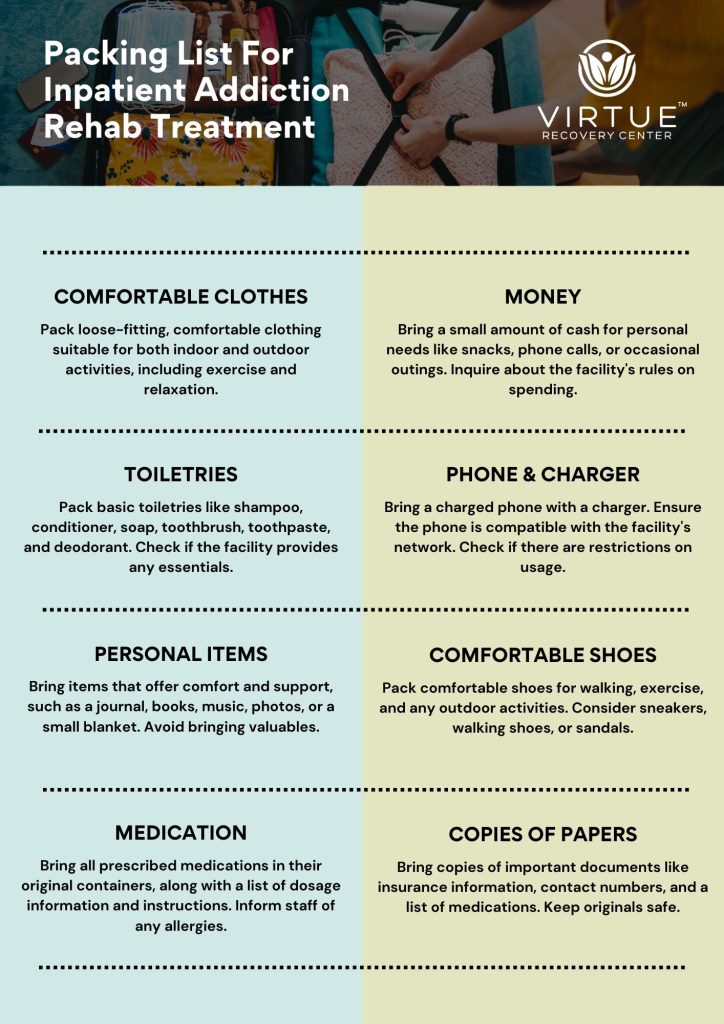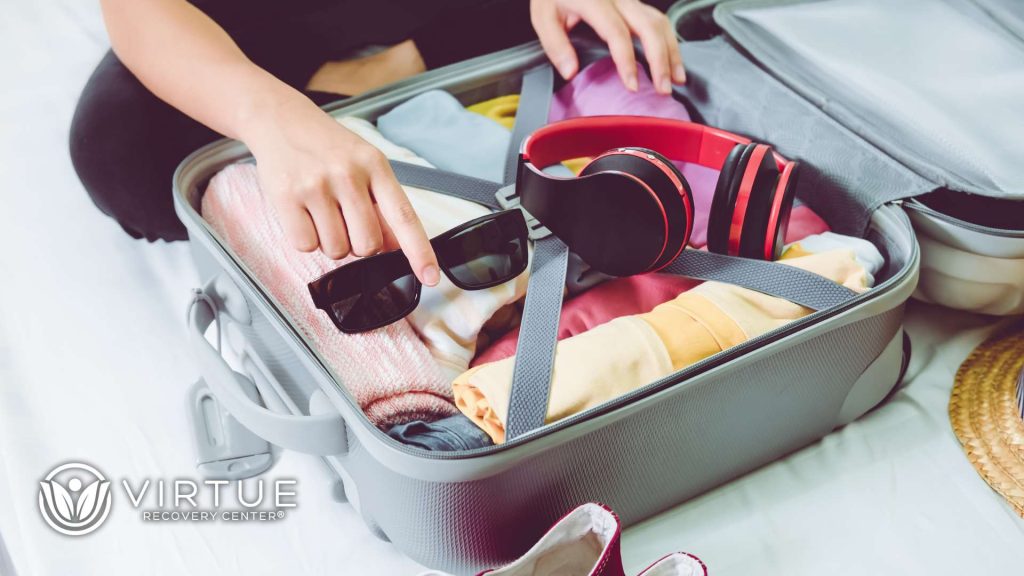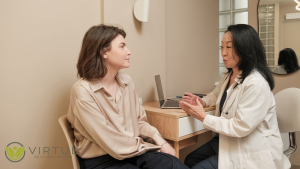Key Takeaways
-
Packing smart helps you feel more prepared and less anxious before starting inpatient rehab.
-
Bring comfortable clothes, basic toiletries, medications, and personal comfort items.
-
Leave behind prohibited items like alcohol, drugs, valuables, and electronics with internet access.
-
Every rehab center has its own policies, so check with your facility before packing.
-
Virtue Recovery Las Vegas offers support for your full recovery journey—starting with what to pack.
Introduction
Starting inpatient rehab is a big and important step. It’s a chance to leave behind old habits and focus fully on healing. But before you begin this life-changing journey, you might be wondering:
What should I bring to rehab?
That’s a great question. Packing the right way can help you feel more comfortable, more confident, and less stressed. This article will walk you through what to pack, what to leave at home, and how to make sure you’re fully prepared for inpatient addiction treatment.
Why It’s Important to Pack the Right Way for Rehab
Packing isn’t just about filling a suitcase—it’s about setting yourself up for success.
If you bring too much, you may be distracted. If you forget something important, you may feel unprepared. That’s why it’s important to know what to pack ahead of time and check your rehab center’s policies.
Having the right items can help you stay focused, feel more at ease, and support your mental, emotional, and physical health during treatment.
Essential Items to Pack for Inpatient Rehab
Comfortable Clothing
Bring loose-fitting, comfy clothes for every part of your day—relaxing, exercising, going to therapy, or sleeping. Pack enough for about 7–10 days, since many centers offer laundry.
Don’t forget:
-
T-shirts and sweatshirts
-
Sweatpants or yoga pants
-
Pajamas
-
Undergarments and socks
-
A jacket or hoodie (depending on the season)
Avoid clothing that’s revealing or has references to drugs, alcohol, or violence.
Basic Toiletries
Pack essential hygiene items such as:
-
Shampoo and conditioner
-
Toothbrush and toothpaste
-
Soap or body wash
-
Deodorant
-
Hairbrush or comb
Make sure none of your products contain alcohol, as many rehab centers don’t allow them. Also, avoid aerosol cans or glass containers.
Comfortable Shoes
You’ll want practical shoes for walking, light exercise, and relaxing indoors. Consider:
-
Sneakers or walking shoes
-
Slip-on shoes or slippers
-
Sandals with straps (if allowed)
Leave high heels or flashy footwear at home.
Prescription Medications
Bring all current medications in their original pharmacy containers with clearly labeled instructions. Also, bring:
-
A list of dosages
-
Instructions from your doctor
-
A list of any known allergies
Do not bring loose pills or over-the-counter medications unless approved by your treatment center.
Money and Identification
Bring only what you need:
-
A small amount of cash for snacks, vending machines, or approved outings
-
Your photo ID
-
Insurance card and emergency contact information
Ask if the rehab center has a secure place to store valuables, though it’s best to leave expensive items at home.
Helpful Comfort and Support Items to Bring
Rehab is about more than healing your body. It’s about supporting your mind and heart, too.
Consider bringing:
-
A journal or notebook for reflection
-
Books or reading materials (check if fiction or spiritual books are allowed)
-
Family photos or small, meaningful keepsakes
-
A cozy blanket or pillow (if permitted)
-
Music players without internet access, such as an MP3 player
These items can provide comfort and help you feel more at home.
Important Documents and Contact Information
It’s helpful to have:
-
A list of emergency contacts
-
Doctor and therapist names and numbers
-
A written list of all medications and dosages
Keep these in a folder or envelope you can easily access.
Items to Leave at Home
Many items are restricted for safety and privacy reasons. Most rehab facilities will not allow:
-
Drugs, alcohol, or any substance-related paraphernalia
-
Revealing or offensive clothing
-
Laptops, tablets, or phones with internet access (unless permitted)
-
Expensive jewelry or valuables
-
Food, candy, or outside drinks
-
Weapons or sharp items
-
Vape devices, cigarettes, or lighters (unless your program allows and supervises tobacco use)
Always check your facility’s full list of prohibited items.
Check With Your Rehab Center About Specific Policies
Every treatment center is different. Some may allow more personal freedom, while others are stricter.
Ask questions like:
-
Can I use my phone at certain times?
-
Are there specific clothing rules?
-
Can I bring makeup or grooming tools?
-
Is there a limit on how many items I can bring?
By knowing the rules ahead of time, you’ll avoid surprises—and pack smarter.
Visual Guide: Rehab Packing List Infographic
To make packing even easier, we’ve created a simple infographic to use as a checklist.

This visual guide covers everything from clothing and toiletries to documents and comfort items. Use it as a last-minute check before you head to rehab.
Conclusion: Get Ready for Your Recovery Journey
Going to rehab is one of the most important decisions you can make. It’s a step toward freedom, healing, and a better life. And it all starts with being prepared.
By packing the right way, you’ll walk through the doors of rehab ready to focus on your recovery—not your suitcase.
Call Virtue Recovery Las Vegas at 866-520-2861 to speak with our admissions team. We’ll help you get started, answer any packing questions, and guide you every step of the way.
FAQs About Having an Addiction Rehab Packing List for Inpatient
What should I bring to rehab?
It’s important to pack for rehab with items that will support your recovery. A general list includes comfortable clothing, toiletries, personal items, and any necessary medications. Always check with the specific treatment facilities for their packing list guide.
What items are not allowed in rehab?
Each recovery center has its own rules, but typically items like drugs or alcohol, sharp objects, and certain electronics are not allowed. Always contact the treatment center to confirm what you can and cannot bring to rehab.
How can I prepare for inpatient treatment?
To prepare for inpatient treatment, consider packing items that will help you feel comfortable and supported, such as your favorite books, journals, or art supplies. Focus on your recovery journey by bringing items that promote relaxation and self-care.
Is there a specific clothing you should bring to rehab?
When you leave for rehab, it’s recommended you bring comfortable, casual clothing suitable for daily activities. Pack enough to last the duration of your stay, keeping in mind the need for both warmth and comfort.
Do I need to bring my own toiletries to rehab?
Yes, most treatment programs recommend you bring personal toiletries, like shampoo, soap, toothpaste, and any other hygiene products you prefer. Ensure that these items are in accordance with the facility’s guidelines.
Can I bring electronics or my phone to rehab?
Many centers allow you to bring limited electronic devices, but it’s common for treatment facilities to restrict phone usage to encourage focus on recovery. Check the specific rules of the rehab center where you will be staying.
What should I remember to pack for drug rehab specifically?
When you pack for drug rehab, include comfortable clothing, personal hygiene items, any prescribed medications, and items that can help you cope, like a journal or a book. Always refer to the packing list for inpatient rehab provided by the facility.
What do I need to bring if I go to alcohol rehab?
If you go to alcohol rehab, you should bring similar items as for drug rehab. This includes comfortable clothing, toiletries, medications, and personal items that provide comfort and support during your treatment journey.
How should I pack for rehab if I’m struggling with addiction?
If you’re struggling with addiction, focus on packing items that will aid your recovery. Consider bringing supportive materials like self-help books, a journal, and comfortable clothing to make your stay as positive as possible.
Resources
https://nida.nih.gov/publications/drugs-brains-behavior-science-addiction/drug-misuse-addiction
https://www.nhs.uk/live-well/addiction-support/addiction-what-is-it/









